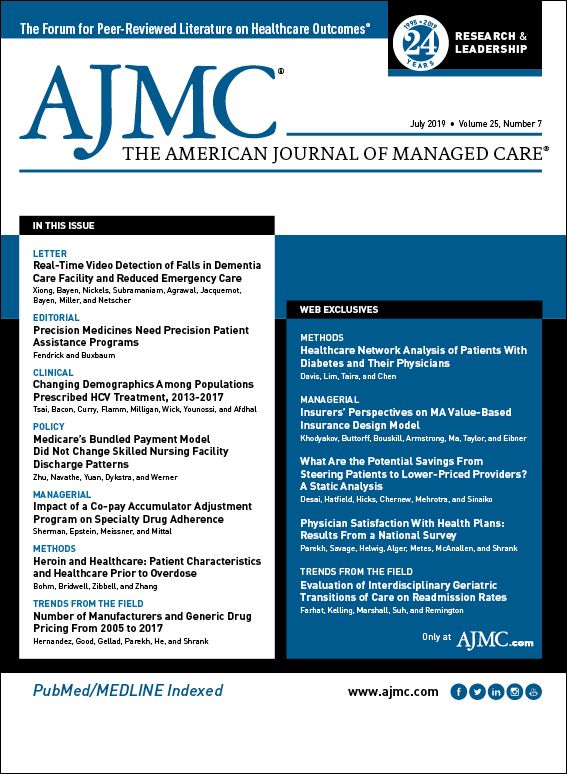- Center on Health Equity & Access
- Clinical
- Health Care Cost
- Health Care Delivery
- Insurance
- Policy
- Technology
- Value-Based Care
From the Editorial Board, July 2019: Robert W. Dubois, MD, PhD
Concerns about rising healthcare spending and persistent low-value care are neither new nor unique to the United States. In the United Kingdom, Canada, and Australia, the government (or agencies deputized by it) routinely assesses the cost-effectiveness of new services, with a particular focus on medications.
Cost-effectiveness reflects the incremental cost of a service compared with its incremental benefit, often termed the “incremental cost-effectiveness ratio.” In the United Kingdom, the National Institute for Health and Care Excellence (NICE) commissions these cost-effectiveness assessments and makes recommendations to the National Health Service regarding what to fund. In the United States, this role is filled—albeit less formally—by the Institute for Clinical and Economic Review (ICER).
The approach to value assessment in the United States and the United Kingdom raises 2 concerns. First, an analysis—such as those from NICE and ICER—producing a single incremental cost-effectiveness ratio assumes that all patients are the same. Patients differ in clinical severity, level of functional impairment, the value they place on length and quality of life, ability to work, and preferences toward the complexity of a treatment regimen or the side effects that may ensue.
Given this myriad of differences, a single incremental cost-effectiveness ratio, or even a few subgroup analyses, cannot adequately reflect what is important to a diverse group of patients. To reflect those important differences, a range of values or multiple incremental cost-effectiveness ratios are needed.
Of equal concern, only a single organization effectively coordinates cost-effectiveness assessments in each country: NICE, by law in the UK; and ICER, by practice in the United States, where reviews are used by commercial and government payers. Having a single entity assumes that the incremental cost-effectiveness ratios they produce are both reliable and valid. But if 2 analyses were performed at the same time by different groups, would the results be the same? Close? Or quite different? Several recent analyses suggest that conclusions may differ.
Perhaps most notable is a new comparison of cost-effectiveness assessments produced for NICE with those produced by ICER. Comparing the results of each effort, substantial differences were noted, with analyses of the same drug producing incremental cost-effectiveness ratios that varied 3- to 6-fold. Some of the difference could be explained by differing prices in the 2 countries, but choices made during the modeling efforts are also likely to have caused markedly varying conclusions.1
Similarly, the Asthma and Allergy Foundation of America reanalyzed ICER assessments for several new asthma therapies, slightly varying the assumptions used. The AAFA found that by incorporating the effect of the disease on productivity, what was deemed overpriced by ICER’s assessments was now a good value using ICER’s threshold.2
One size can’t fit all: A single incremental cost-effectiveness ratio cannot reflect the value of new treatments for a diversity of patients, and one group performing those assessments will not suffice. In brief, it would be far NICE(r) to have multiple ICERs, or have multiple assessments be performed by multiple groups. Patients, providers, and payers would then review those multiple assessments and make more educated decisions—and more targeted decisions—based upon them.
References
1. Cockerill KE, Ward K, Higgins A, Gaebler JA. A comparison between ICER and NICE cost-effectiveness models. Poster presented at: ISPOR 24th Annual International Meeting; May 21, 2019; New Orleans, LA.
2. Mendez K. ICER can do better for patients. J Manag Care Spec Pharm. 2019;25(5):514-516. doi: 10.18553/jmcp.2019.25.5.514.

Blister Packs May Help Solve Medication Adherence Challenges and Lower Health Care Costs
June 10th 2025Julia Lucaci, PharmD, MS, of Becton, Dickinson and Company, discusses the benefits of blister packaging for chronic medications, advocating for payer incentives to boost medication adherence and improve health outcomes.
Listen
HEDIS Glycemic Goal Achieved Using Control-IQ Technology
December 22nd 2025A greater proportion of patients with type 1 diabetes who used automated insulin delivery systems vs multiple daily injections achieved the Healthcare Effectiveness Data and Information Set (HEDIS) glycemic measure.
Read More

